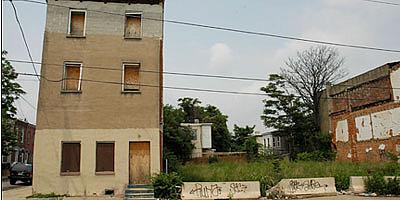Investigating Urban Health: A Philadelphia Story
Carolyn Cannuscio comes from an avid newspaper-reading family. The health and science sections were always the table favorites. She recalls a conversation with her father where he imparted his wish that she do "something big" with her career. "Write a letter to Jane Brody about your work!" he said.
Carolyn Cannuscio, a social epidemiologist from the University of Pennsylvania, opened this year's California Health Journalism Fellowships seminars with a presentation about the Health of Philadelphia Photo-documentation Project. Luckily, Brody, health columnist for The New York Times and member of the Fellowships' advisory board, was in the audience. Though not journalism, Cannuscio's research on the health of Philadelphians provides new ways of thinking about storytelling.
"When we talk about whether or not Philadelphia is a healthy place," she says, "the answer depends on the neighborhood where you live."
Cannuscio and her team gave cameras to staff photographers and community members to systematically document neighborhood health through images and voice. Beginning in 2006, they interviewed residents block by block in neighborhoods of different income levels. The differences in health between the three neighborhoods they followed were stark.
(Photo by Aaron Walker, courtesy of the Health of Philadelphia Photo-documentation Project)
Shelter?
Middle-class Center City was safe -- people left their strollers outside their homes -- and sidewalks and store fronts were well-maintained. In Fairmont, homes were in poorer condition but "still standing." In North Philadelphia, photographers found the remains of abandoned "homes in imminent danger of collapse" next door to where the residents lived.
Still, health news and public health research are dominated by personal health concerns, leisure time and recreational opportunities -- topics that rarely came up in Cannuscio's interviews about the health concerns of many Philadelphia communities. Smoking cessation to reduce lung cancer and the reduction of obesity are important, for example, but residents were more concerned that single cigarettes --- "lucies" -- were sold in corner stores.
In North Philadelphia, they weren't talking about health care or doctors or hospitals. They were worried about housing quality, the food environment and the decline of community. While residents of Center City wanted more recreational space to exercise, in Fairmont and North Philadelphia residents had more immediate concerns. Philadelphia's high-crime neighborhoods are places where residents position their furniture strategically to avoid gunshots that might come through the windows.
"What registered in my mind is that little else registers as a health concern if safety is not assured," Cannuscio said.
Bright spots in Philadelphia's low-income neighborhoods include public arts projects that involve at-risk youth and community gardens tended by families. Even these gardens can have complex effects, however. Property prices have gone up around some major projects, forcing residents out of their homes.
"Even places with seemingly intractable, complex health problems change," says Cannuscio. "It's my job as an epidemiologist and your job as a journalist to watch it."
Here are some takeaway story ideas to help track changes in the health of communities: What are the health effects of the foreclosure crisis? How important are homes to health? And can mixed-income neighborhoods improve health outcomes? For more information about Cannuscio's project, read the full paper at PubMed.
Get a sneak preview of the fellows investigative projects and follow #chjf on Twitter for real-time updates and through the weekend.
